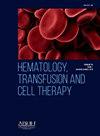THE INFLAMMASOME DRIVES MICROVASCULAR IMPAIRMENT IN MOUSE MODELS OF INTRAVASCULAR HEMOLYSIS
IF 1.8
Q3 HEMATOLOGY
引用次数: 0
Abstract
Introduction
Intravascular hemolysis (IVH) results in the release of damage-associated molecular patterns (DAMPs) into the circulation, particularly hemoglobin (Hb) and heme, which can trigger NLRP3 inflammasome activation and a sterile inflammatory response. Complications of hemolytic diseases include thrombosis, inflammation, and organ damage. In sickle cell disease (SCD), IVH can lead to vaso-occlusive crises and ischemic complications such as cutaneous leg ulcers, acute chest syndrome, and multiorgan infarction.
Aim
To investigate the in vivo effects of inflammasome formation on microvascular function and its role in the pathophysiology of hemolytic conditions.
Methods
We utilized two murine models to simulate intravascular hemolysis: an acute model where C57BL6 mice received osmotic stress (150 μl sterile water, i.v. -HEM); and a chronic model induced by repeated low doses of phenylhydrazine (10 mg/kg, i.p. -CHEM). Control mice received saline under similar conditions. Microvascular dysfunction was assessed by laser Doppler fluxometry (LDF) in the skin of the pelvis and by intravital microscopy of the cremaster muscle. Inflammasome activation was evaluated via flow cytometry measurement of caspase-1 (casp-1) activity, measurement of interleukin (IL)-1β and IL-18 release by ELISA, and NLRP3 protein expression in the liver using western blot.
Results and discussion
Our findings show that acute hemolysis immediately increased plasma cell-free Hb and heme levels in HEM mice, along with decreased Hb scavenger haptoglobin (Hp). CHEM mice also displayed a significant depletion of hemopexin (Hx), indicating the persistent removal of this heme-neutralizing protein. These results confirm that these mouse models effectively mimic acute and chronic hemolytic stress. Acute IVH resulted in microvascular dysfunction characterized by a vaso-occlusive-like process, as demonstrated by an increase in rolling, adherent, and extravasated leukocytes. The blood flow velocity of HEM mice was reduced in the microcirculation, resulting in impaired tissue blood perfusion. These findings were accompanied by increased casp-1 activity in peripheral monocytes and elevated levels of IL-1β and IL-18, all hallmarks of inflammasome formation, suggesting that inflammasome assembly during hemolytic stress contributes to tissue microcirculation dysfunction. While acute hemolysis caused microvascular defects and impaired blood perfusion in mice, chronic hemolysis significantly affected the liver, leading to an increase in the macrophage population, which displayed elevated active casp-1 and increased NLRP3 protein expression. Next, we investigated whether the NLRP3 inflammasome contributes to hemolysis-induced microvascular pathology. As expected, casp-1 activation was reduced by the NLRP3 inhibitor, MCC950, in both the neutrophils and monocytes of HEM mice. Moreover, NLRP3 inflammasome inhibition reduced leukocyte recruitment to the venule walls of HEM mice, indicating an improvement in hemolysis-induced microvascular dysfunction. This was further corroborated by LDF, which showed improved blood perfusion in the skin of MCC950-treated HEM mice.
Conclusion
These results demonstrate that NLRP3 inflammasome assembly, in response to hemolysis, compromises microvascular function by modulating leukocyte adhesion to the endothelium and impairing blood flow to tissues, which could contribute to clinical complications in hemolytic disorders such as SCD.
炎症小体驱动血管内溶血小鼠模型中的微血管损伤
导言血管内溶血(IVH)会导致损伤相关分子模式(DAMPs),特别是血红蛋白(Hb)和血红素释放到血液循环中,从而引发NLRP3炎性体激活和无菌炎症反应。溶血性疾病的并发症包括血栓形成、炎症和器官损伤。目的研究体内炎症小体的形成对微血管功能的影响及其在溶血病病理生理学中的作用。方法我们利用两种小鼠模型模拟血管内溶血:一种是急性模型,C57BL6小鼠接受渗透压(150 μl无菌水,静脉注射-HEM);另一种是慢性模型,由重复低剂量苯肼(10 mg/kg,静脉注射-CHEM)诱导。对照组小鼠在类似条件下接受生理盐水治疗。盆腔皮肤的激光多普勒通量测定法(LDF)和绉肌的眼内显微镜检查评估了微血管功能障碍。通过流式细胞仪测量 caspase-1 (casp-1) 活性、ELISA 测量白细胞介素 (IL)-1β 和 IL-18 的释放以及 Western 印迹检测肝脏中 NLRP3 蛋白的表达,评估炎症小体的激活情况。CHEM 小鼠的血红素(Hx)也明显减少,表明这种血红素中和蛋白被持续清除。这些结果证实,这些小鼠模型能有效模拟急性和慢性溶血应激。急性 IVH 会导致微血管功能障碍,其特征是血管闭塞样过程,表现为滚动、粘附和外渗白细胞的增加。HEM 小鼠微循环中的血流速度降低,导致组织血液灌注受损。这些发现伴随着外周单核细胞中 casp-1 活性的增加以及 IL-1β 和 IL-18 水平的升高,而这些都是炎症小体形成的标志。急性溶血会导致小鼠微血管缺损和血液灌流受损,而慢性溶血则会对肝脏造成显著影响,导致巨噬细胞数量增加,巨噬细胞的活性casp-1升高,NLRP3蛋白表达增加。接下来,我们研究了NLRP3炎性体是否有助于溶血引起的微血管病变。不出所料,NLRP3抑制剂MCC950可减少HEM小鼠中性粒细胞和单核细胞中casp-1的活化。此外,抑制 NLRP3 炎性体可减少 HEM 小鼠静脉壁的白细胞募集,这表明溶血引起的微血管功能障碍得到了改善。这些结果表明,NLRP3 炎性体在溶血反应中通过调节白细胞对内皮的粘附和损害组织的血流来损害微血管功能,这可能会导致溶血性疾病(如 SCD)的临床并发症。
本文章由计算机程序翻译,如有差异,请以英文原文为准。
求助全文
约1分钟内获得全文
求助全文
来源期刊

Hematology, Transfusion and Cell Therapy
Multiple-
CiteScore
2.40
自引率
4.80%
发文量
1419
审稿时长
30 weeks
 求助内容:
求助内容: 应助结果提醒方式:
应助结果提醒方式:


